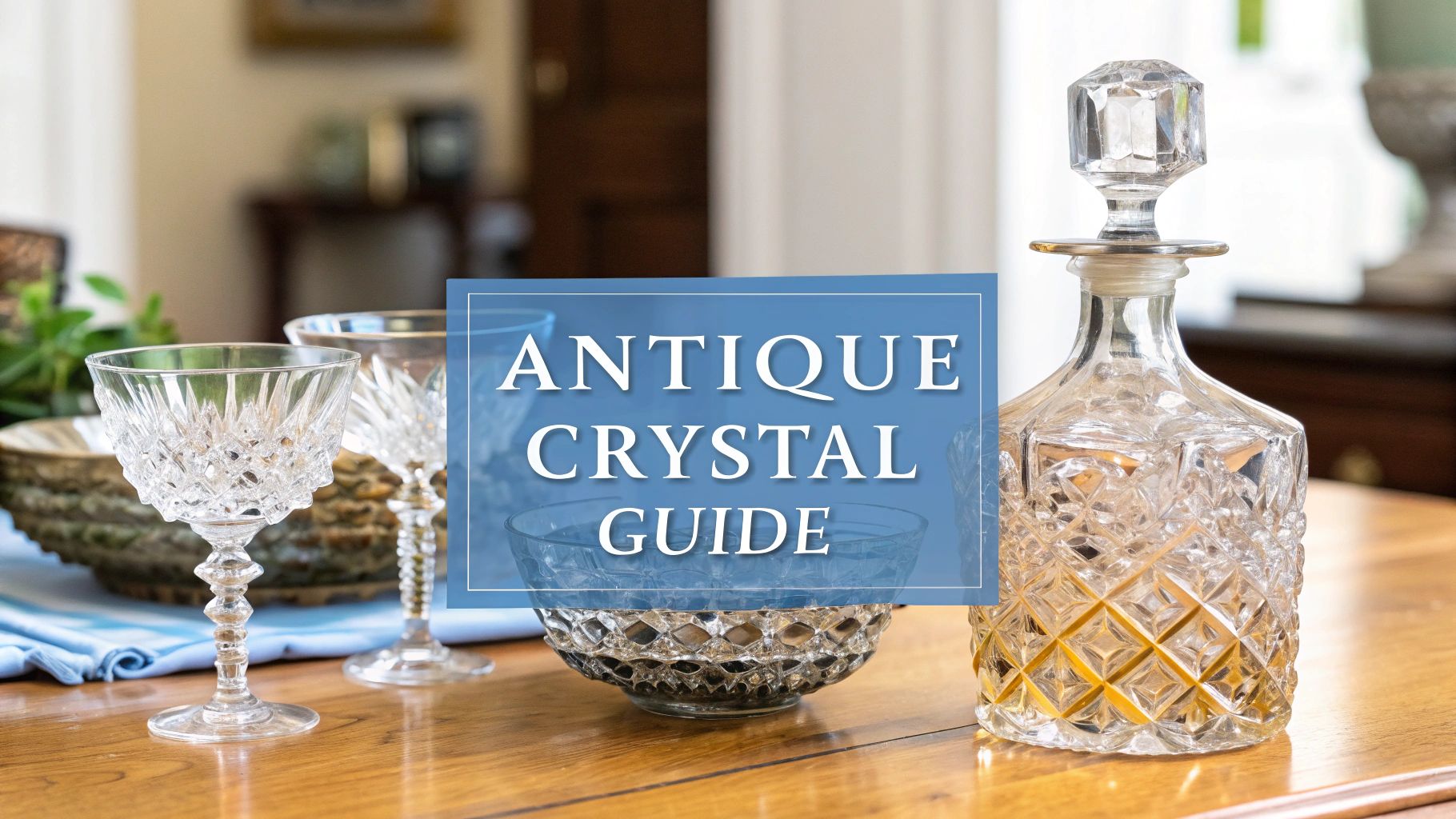Antique crystal isn't just old glass. It's a special type of finely crafted glassware containing minerals like lead oxide, which give it that signature weight, brilliant sparkle, and a clear, bell-like ring when tapped. These pieces are more than just functional or decorative items; they're little time capsules, reflecting the artistry and social customs of the eras they come from. Their charm lies in their beauty, their history, and the unique story each one holds.
The Enduring Allure of Antique Crystal
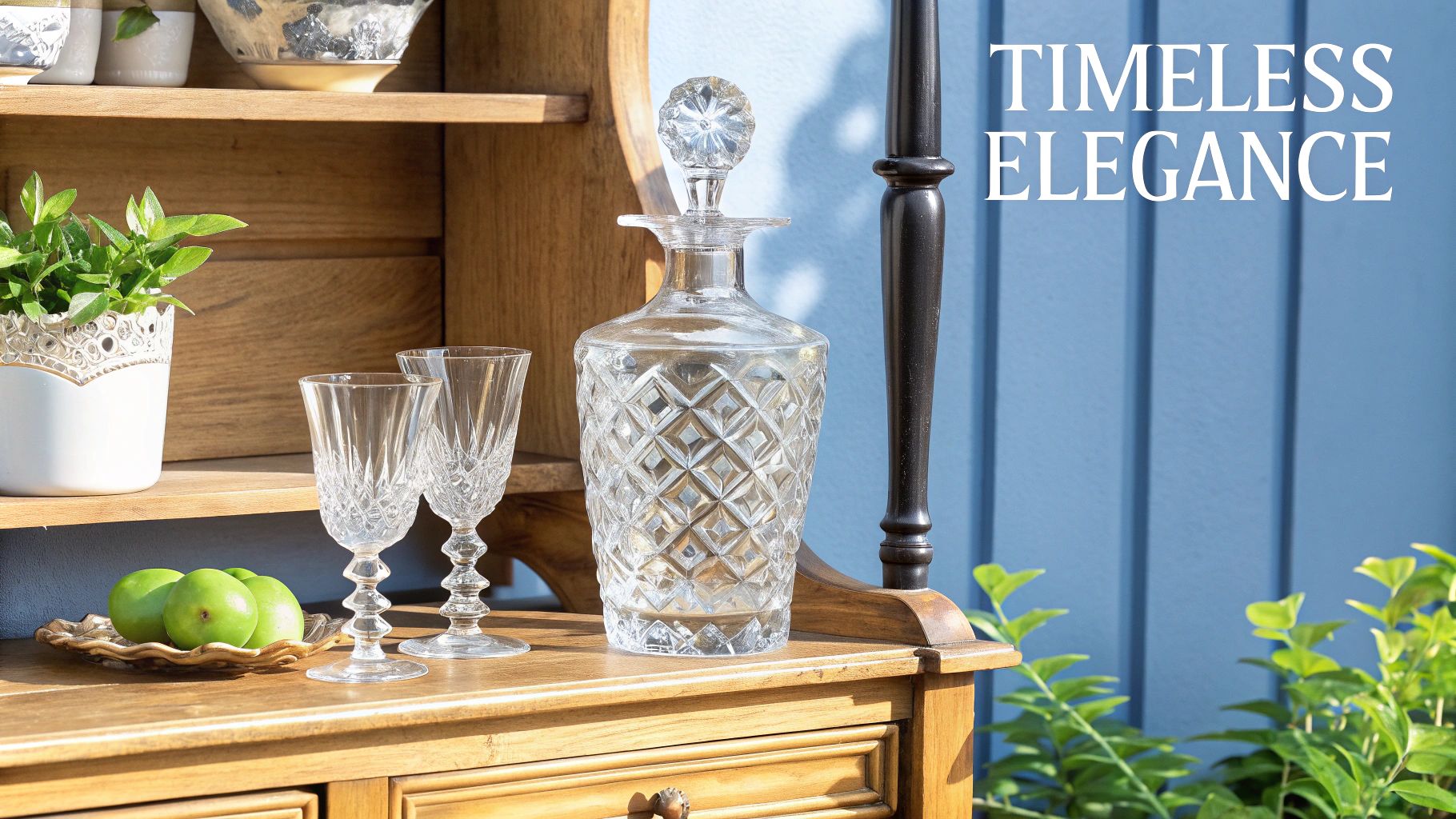
There's something truly special about antique crystal that modern pieces can't quite capture. When you hold a hand-cut crystal goblet, you can almost feel the history in it. Each precise facet tells a story of incredible craftsmanship from a time long past. This isn't just about owning something old; it's about making a tangible connection to history.
In a world filled with mass-produced goods, it’s no surprise that collectors are once again captivated by items with real character and soul. An antique crystal decanter or a set of brilliant goblets does more than just sit on a shelf—it becomes a conversation starter, bringing a touch of timeless elegance into any home.
Why We Still Cherish Old Crystal
So, why the renewed love for old crystal? It's a mix of aesthetics, a desire for sustainability, and a genuine respect for artistry. People are looking for meaningful alternatives to the throwaway culture, and antique pieces are the perfect fit.
- A Story in Every Piece: Unlike a brand-new item from a factory, every piece of antique crystal has lived a life. It's been part of family celebrations and quiet moments, passing through generations and gathering stories along the way.
- Unmatched Craftsmanship: Before machines took over, making crystal was a true art. The intricate hand-cut patterns, delicate etchings, and blown forms show a level of human skill that is incredibly rare today. Each piece is its own small masterpiece.
- Sustainable Elegance: Choosing antique is a naturally green choice. You're giving a beautiful object a new chapter, which reduces waste and the environmental cost of new manufacturing. It’s a simple way to embrace sustainability without sacrificing style.
At its heart, collecting antique crystal is about appreciating things made with purpose and care. It’s a nod to the idea that true quality and beauty never go out of style, connecting us to a long legacy of human creativity.
Your Journey into Crystal Collecting
Diving into the world of antique crystal can feel a little overwhelming at first. With countless patterns, makers, and periods to learn about, it's hard to know where to start. The trick is to begin with the basics—learning what separates crystal from glass and how to spot the signs of authenticity and quality.
Think of this guide as your trusted companion on this sparkling adventure. We'll give you the foundational knowledge you need to navigate the world of antique crystal with confidence. From telling true crystal from plain glass to identifying famous makers and caring for your finds, you'll gain the skills to build a collection you'll treasure for years to come.
How to Tell Crystal from Glass
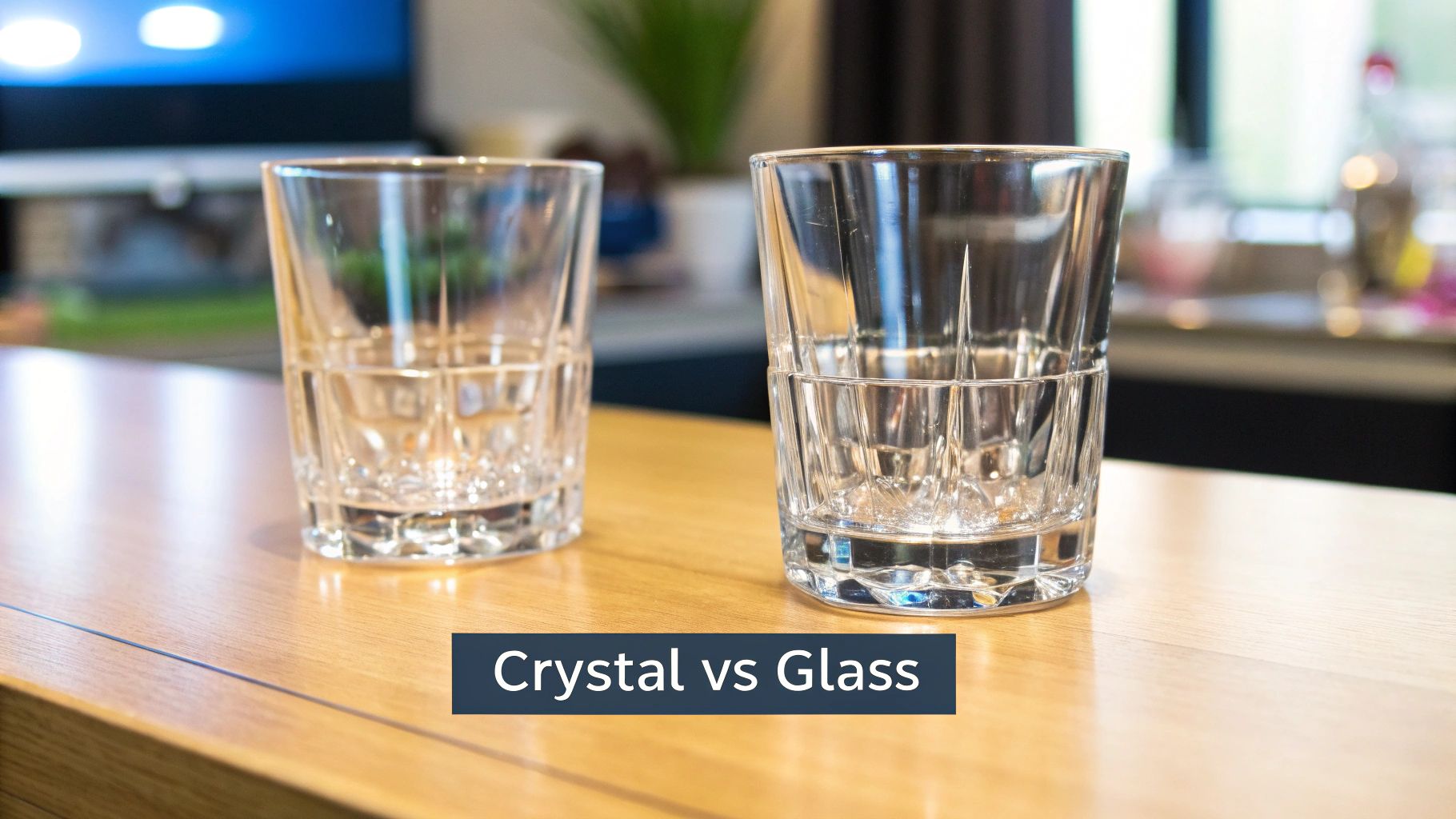
Learning to distinguish true antique crystal from ordinary glass is the first real step for any collector. At first glance, they might look alike, but their very makeup is what sets them worlds apart. The secret ingredient? Lead oxide.
Think of it like this: regular glass is the simple, serviceable cotton of the fabric world. Crystal, on the other hand, is the silk. The addition of lead oxide is what transforms the basic silica mix from something purely functional into something brilliant, heavy, and resonant. It's this special ingredient that gives antique glassware crystal all of its famous characteristics.
Luckily, you don't need a science lab to tell the difference. Your own senses are the best tools you have.
Feel the Difference in Weight
The first and most straightforward test is simply picking it up. Hold a piece of suspected crystal in one hand and a regular glass of about the same size in the other. The difference is often immediate and surprising.
Crystal will feel noticeably heavier, almost deceptively so for its size. This satisfying heft comes directly from the lead content, making the piece feel substantial and luxurious. It's a classic sign of quality that you can feel right in your palm.
Listen for the Signature Ping
Next, let your ears do the work. This is a favorite trick of seasoned collectors because it’s so reliable.
- Hold the item carefully by the stem or base, making sure the bowl is free.
- Gently tap the rim with your fingernail. A light flick is all it takes.
- Listen closely. Regular glass will make a short, dull thud. It’s a dead sound with no resonance.
But crystal? Crystal sings. The minerals within the structure vibrate, creating a clear, bell-like "ping" that seems to hang in the air for a moment. That sustained, musical note is the unmistakable sound of true crystal.
The market valuation of lead crystal is heavily influenced by its quality, age, and condition. Genuine lead crystal typically contains at least 24% lead oxide, which enhances its weight and brilliance. Appraisers look for signs of age, maker's marks, and any damage, as even rare but damaged pieces can retain significant value. Discover more insights into valuing lead crystal to understand what makes a piece truly collectible.
Look for the Rainbow Sparkle
The final test is the most beautiful. The lead in crystal gives it a high refractive index, which is just a fancy way of saying it bends light in a spectacular way.
Hold the piece up to a sunny window or a bright lamp and turn it slowly. True crystal will act like a prism, splitting the light into a dazzling rainbow. You'll see brilliant sparkles and flashes of color dance through the cuts. Plain glass just can’t do this; it will look clear and relatively flat in comparison. That fiery, vibrant sparkle is the ultimate visual proof that you're holding authentic antique glassware crystal.
Quick Guide to Identifying Crystal vs Glass
Sometimes you just need a quick reference. This little cheat sheet breaks down the key differences to help you identify pieces on the fly.
| Characteristic | Antique Crystal | Regular Glass |
|---|---|---|
| Weight | Surprisingly heavy and dense for its size. | Feels lighter and less substantial. |
| Sound | A clear, lingering "ping" when tapped. | A short, dull "thud" or "clink." |
| Light | Splits light into a rainbow; brilliant sparkle. | Appears clear with little to no sparkle. |
| Rim | Often thinner and more finely cut. | Usually thicker and smoother. |
| Clarity | Exceptionally clear and luminous. | Can have a slight tint (often green). |
Remember these simple tests, and you'll quickly train your eyes, ears, and hands to spot the difference. It’s a skill that turns every trip to an antique shop into a treasure hunt.
Recognizing Famous Makers and Iconic Patterns
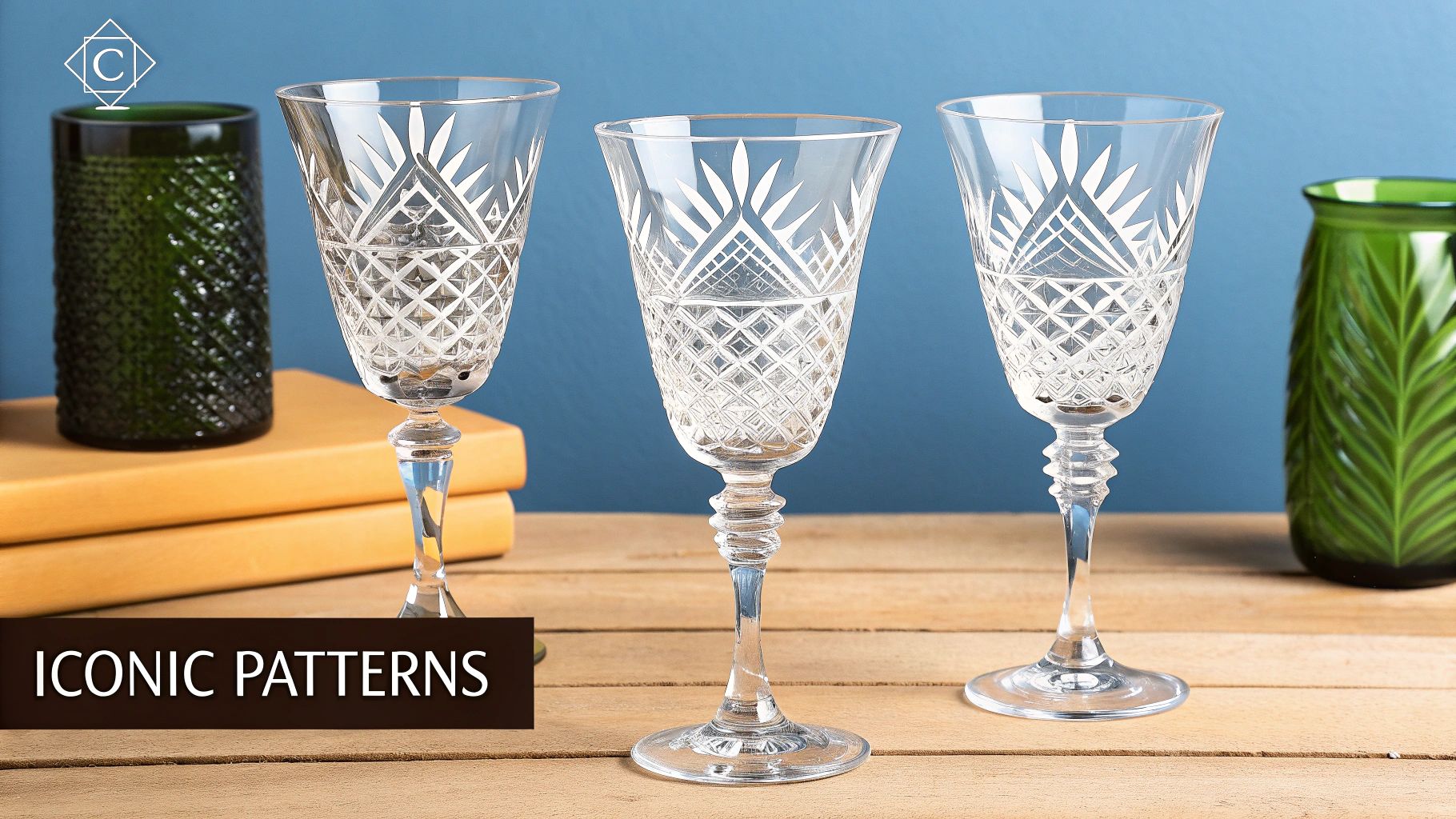
So, you've got the hang of telling crystal apart from regular glass. Now for the fun part: learning to spot the legendary names behind the most sought-after pieces. Think of these manufacturers as the rock stars of the antique glassware crystal world. Each one had a signature style and a design philosophy that made their work instantly recognizable.
Getting to know these makers and their most famous patterns is like learning the difference between a Monet and a Van Gogh. It completely changes how you see a piece. Suddenly, it’s not just a beautiful object; it’s an artifact with a known history and a distinguished pedigree. Let's take a look at some of the titans you’re most likely to come across in your treasure hunts.
Waterford Crystal: The Irish Legend
For many, the first name that springs to mind when they hear "fine crystal" is Waterford. Founded way back in 1783 in the Irish port town of the same name, the company quickly built its name on producing crystal with extraordinary clarity and sparkle. The secret to Waterford's magic is its deep, intricate wedge cuts that make light dance.
The brand's most famous pattern, without a doubt, is 'Lismore'. It was introduced in 1952 and its beautiful blend of diamond and wedge cuts struck a chord with people everywhere. In fact, it remains the world's best-selling crystal pattern, which is great news for collectors because it's a relatively common find.
- What to look for: Look for a weighty feel, exceptionally clear crystal (sometimes with a faint grey or blue tint), and incredibly precise, deep cuts.
- Iconic Patterns: Lismore is the big one, but also keep an eye out for Colleen and Alana.
Baccarat: The French Icon of Luxury
If Waterford is an Irish legend, Baccarat is the embodiment of French luxury. Crafting stunning crystal since 1816, Baccarat has been the go-to for kings, tsars, and presidents for over two centuries. Their work is simply flawless.
Their most enduring design is probably the 'Harcourt' pattern, which dates all the way back to 1841 and is still in production today. With its bold, architectural look—six flat cuts on the bowl, a hexagonal foot, and a distinct knobbed stem—holding a Harcourt glass feels like you're holding a piece of royal history.
Baccarat’s commitment to quality was so intense that the company used to destroy any piece that had even the slightest imperfection. This obsession with perfection is exactly why antique Baccarat is so treasured by collectors.
Lalique: The Art Nouveau and Art Deco Master
Lalique is a different beast altogether. While Waterford and Baccarat focused on traditional cut crystal, Lalique was all about artistry and sculpture. Founded by the visionary René Lalique in the late 19th century, the company moved from jewelry into glass art, and the world is better for it. Lalique's signature is a frosted, satin-like finish, often used to create stunning depictions of nature—flowers, birds, and the female form.
Lalique’s style was the perfect expression of the Art Nouveau and, later, Art Deco movements. Instead of sharp, brilliant cuts, he used molded and pressed glass to achieve soft, almost dreamlike textures. A perfect example is the famous 'Bacchantes' vase, a jaw-dropping piece from 1927 that shows a parade of nude priestesses in frosted crystal.
Identifying Maker's Marks
While patterns give you great visual clues, the most definitive way to identify a maker is by finding their mark. These can be tiny acid-etched logos, engraved signatures, or even old paper labels. Spotting these subtle signatures is a key skill for any serious collector. To really get into the weeds on this, check out our guide on antique glass makers' marks for a detailed breakdown.
Learning about these legendary makers does more than just help you ID your finds. It connects you to a rich history of artistry and craftsmanship. Every piece of antique crystal tells a story—not just of its era, but of the master artisans who poured their skill into bringing it to life.
Mastering the Art of Identification
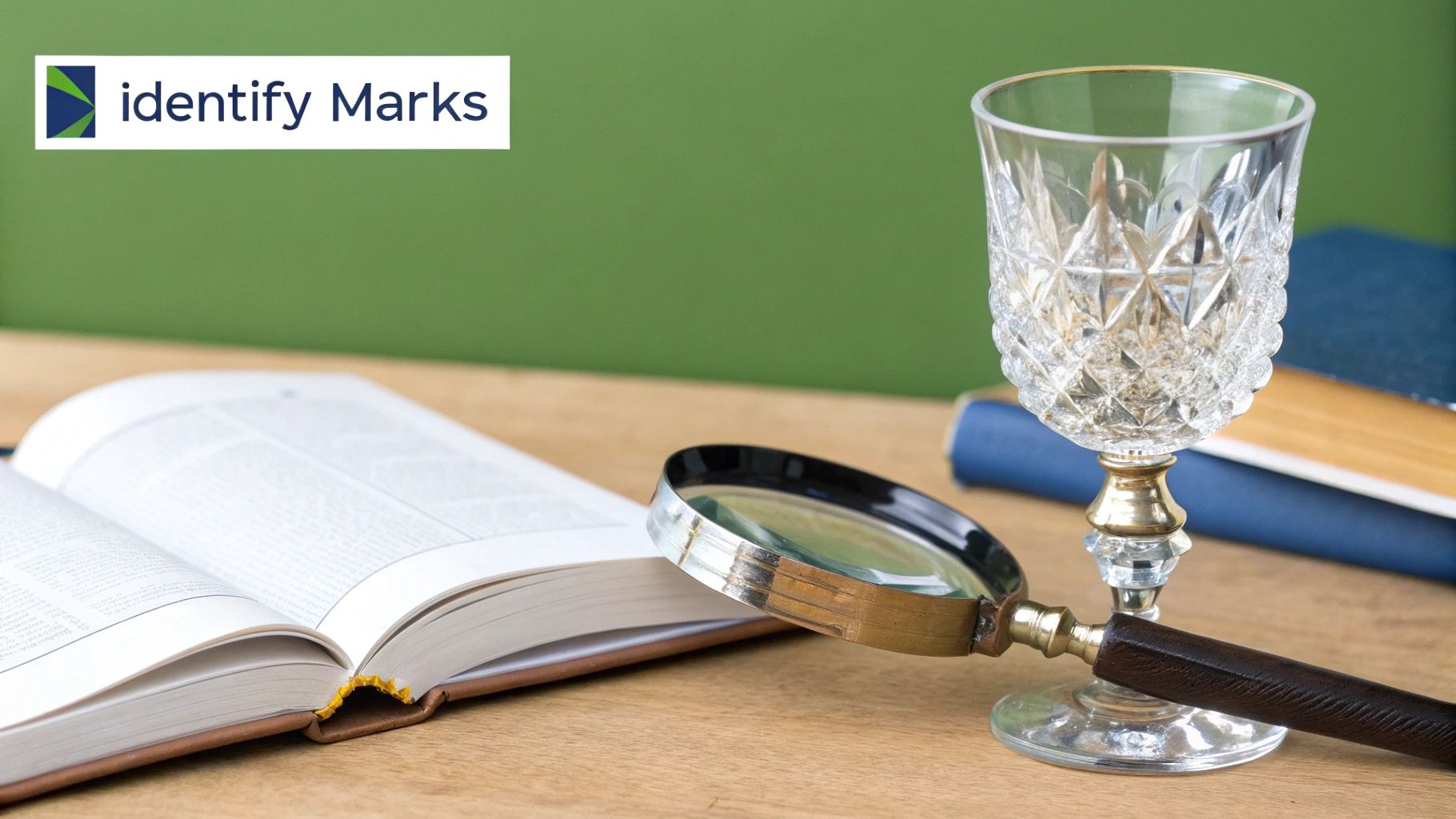
So, you can now confidently tell crystal from glass. That’s the first step. Now, you get to be the detective. Identifying antique glassware crystal is all about looking past the sparkle to find the clues that reveal its maker, age, and unique story. It’s a rewarding process that turns you from a simple admirer into an investigator piecing together history.
Just like a detective, you need to know what to look for. You're searching for the "fingerprints" and "signatures" left behind by the artisans who created the piece. The clearest clue is always a maker's mark, but don't overlook the story told by the style of the cut or the shape of the item itself.
Uncovering the Maker's Mark
The maker’s mark is the holy grail for any collector—it's the manufacturer's signature. These marks are often tucked away on the base, so they don't spoil the design. You’ll probably need good light and maybe a magnifying glass to find them.
These signatures usually appear in a few key forms:
- Acid-Etched Logos: This is the most common marking. It looks like a faint, frosted signature or symbol on the bottom. Waterford, for instance, used an acid-etched gothic script for a huge part of the 20th century.
- Engraved Signatures: Some high-end makers, like Steuben, had artisans hand-engrave a signature into the base. These can be very delicate and easy to miss.
- Hidden Symbols: It's less common, but some manufacturers would work subtle symbols into the pattern itself. Finding one of these is a real treat for a dedicated collector.
Think of a maker's mark as a seal of authenticity. It’s the company's way of proudly claiming their work, providing you with a direct link to the piece's origin and confirming its pedigree in the world of antique glassware crystal.
Reading Clues in the Cut and Form
What if there's no mark? Don't worry, a piece of crystal still has plenty to say. The style of the cuts and the overall shape are powerful clues to its era and even its origin. If you want to go deeper, you can learn more about identifying antique glassware by studying its defining characteristics.
The decorative style, for example, tells you so much. The American Brilliant Period (roughly 1876-1917) is famous for its breathtakingly deep, complex geometric cuts that cover almost the entire piece. That's a world away from the elegant, flowing lines of Art Nouveau or the clean, bold geometry of Art Deco designs.
The physical form is another part of the puzzle. The shape of a wine glass, the design of a decanter's stopper, or the specific use of a bowl can point to a certain time. Social customs changed, and the crystalware people used changed right along with them.
Finding Evidence of Handcrafting
Finally, look for the tell-tale signs that your piece was made by a skilled human, not a machine. The most well-known clue is the pontil mark.
A pontil mark is a small, sometimes rough, circular scar on the base of hand-blown glass. It's the spot where the pontil rod—the tool used to hold the hot glass—was broken off once the work was done. A polished-out pontil mark often indicates a higher-quality piece, but its very presence is a sure sign of older, handmade craftsmanship. This kind of systematic search for markers is a core skill for any collector. While it focuses on minerals, a practical crystal identification guide provides a great look into these systematic methods, which can be applied to all sorts of collectibles.
How to Figure Out What Your Collection Is Worth
It’s exciting to uncover the story behind a piece of antique glass, but let’s be honest—the big question on most collectors' minds is, "What's it actually worth?" Figuring that out isn't just a guessing game. It’s a process, and it really comes down to four key factors.
Think of it like a four-legged stool. If one of those legs is weak or missing, the whole thing gets wobbly. The same goes for the value of your crystal. The four legs are Rarity, Manufacturer, Condition, and Provenance. A piece that hits a home run in all four areas can be a true treasure, but a weakness in just one—even a tiny chip—can send its value tumbling.
The Four Pillars of Value
Let's break down what to look for in each of these areas. They all play a part in determining the final market price, and they often feed into one another. A rare pattern from a famous maker in perfect shape? That's the dream.
Rarity: This is straight-up supply and demand. Was the pattern made for just a year or two? Is it an odd, one-off experimental piece? The fewer of something there are in the world, the more collectors will fight over it.
Manufacturer: A signature from a powerhouse like Baccarat or Lalique immediately gives a piece credibility. That name is like a stamp of quality and artistry, which instantly boosts its desirability and price tag.
Condition: This one is non-negotiable. You have to inspect every piece under a bright light, looking for any and every sign of damage. Even flaws that seem minor can dramatically cut the value.
Provenance: This is the item's life story. Who owned it? Can you trace its history back through a family or a specific event? A great story can turn a modest piece into something truly special.
You can't overstate the importance of condition. A flawless, common piece will almost always be worth more than a rare piece that's badly damaged. Chips, cracks, and cloudiness are the three biggest value-killers for antique glassware crystal.
Why Condition and Color Are So Critical
When you're checking the condition, don't just use your eyes. Gently run your fingertip along every rim, edge, and foot. You'll often feel tiny nicks and flea bites that you'd otherwise miss. And watch out for "sick" glass—that permanent cloudiness, usually from a dishwasher, is irreversible and can slash a piece’s value by over 50%.
Color is another huge factor. The minerals added to create different colors in old glass have a massive impact on collectibility. For example, that beautiful cranberry or pink-red glass, made with gold oxide, almost always fetches the highest prices. On the other hand, colors like blue (from cobalt) or green (from uranium) are generally more common and less expensive, though still very collectible. The richness and rarity of a color tell you a lot about the difficult, hands-on techniques used to make it. You can learn more about how antique glass colors impact value to get a better sense of these market dynamics.
Knowing When to Call in a Pro
Using this framework will get you a solid ballpark estimate, but sometimes you really do need an expert's eye. If you think you've stumbled upon something exceptionally rare, have a piece with a fascinating history, or need to value a large collection for insurance or sale, paying for a professional appraisal is money well spent.
Appraisers live and breathe this stuff. They have access to auction records and a deep knowledge of market trends that you just can't find with a quick online search. More importantly, they can give you certified documentation, which is crucial for insurance claims or selling at a high-end auction. Think of it this way: your research builds the case, but the appraiser is the judge who delivers the final verdict.
Proper Care and Preservation Techniques
Owning a piece of antique crystal is a real joy, but it's also a big responsibility. These stunning pieces are far more porous and delicate than modern glassware, so they need a bit of special attention to keep them sparkling for the next generation.
Think of your antique glassware crystal less like everyday dishes and more like treasured heirlooms. Once you know the right way to clean and store them, you can confidently use and display your collection without worrying about causing harm.
The Gentle Art of Hand Washing
If you take away only one thing, let it be this: never put antique crystal in a dishwasher. It’s the fastest way to ruin it. The high heat, aggressive detergents, and constant jostling can cause permanent cloudiness, scratches, and even tiny stress fractures. Hand washing is the only way to go.
Here's how to do it right:
- Cushion the Sink: Before you start, lay a soft towel or a rubber mat in the bottom of your sink. This simple step prevents a lot of heartbreaking accidents. Take off any rings or bracelets that might scratch the glass, too.
- Use Lukewarm Water: Fill the sink with warm—not hot—water. Sudden, extreme temperature changes can cause thermal shock, which leads to cracks. A few drops of a mild, non-citrus dish soap is all you need.
- Wash One by One: Gently wash each piece individually with a soft microfiber cloth. When washing a goblet, be careful not to twist the stem while holding the bowl; that's the weakest point. For tricky spots inside a vase or decanter, a soft bottle brush can work wonders.
- Rinse and Dry Immediately: Rinse each piece with clean, lukewarm water. To avoid those pesky water spots, dry it right away with a lint-free towel (a flour sack or microfiber cloth works great). A little secret is to gently polish the glass while it's still slightly warm from the rinse water—that’s how you get that brilliant, streak-free shine.
For more tips on tackling tough cleaning jobs, especially for odd-shaped pieces, check out our guide on how to clean antique bottles.
Smart Storage to Prevent Chips and Cracks
How you store your crystal is just as important as how you wash it. Most chips and hairline fractures happen in the cabinet, not the sink. The key is to minimize pressure and contact between pieces.
Keep your collection in a sturdy, enclosed cabinet, preferably away from high-traffic areas where vibrations could be an issue. It’s also wise to keep it out of direct sunlight, which can cause colored crystal to fade over time.
Always store crystal glassware upright on its base. Storing it rim-down puts stress on the most fragile part of the glass and dramatically increases the risk of chipping.
Long-Term Preservation Best Practices
If you’re packing pieces away for long-term storage or preparing for a move, you need to take extra precautions. Never stack your crystal. If you absolutely have to place pieces close together, use soft felt dividers or acid-free tissue paper to create a protective buffer.
Learning the proven protection strategies for packing fragile items is non-negotiable for keeping your collection safe. By making these habits second nature, you’ll ensure your treasured antique glassware crystal remains a brilliant and beautiful part of your home for years to come.
Common Questions About Antique Crystal
Even the most seasoned collectors have questions. When you're out in the field—sifting through dusty antique shops or carefully examining a piece at an estate sale—a few common uncertainties tend to pop up again and again. Let's tackle some of the most frequent ones.
Think of this as a quick-reference guide for those moments when you need a fast, reliable answer. Getting these details right is what separates a casual browser from a confident collector.
Can I Actually Use My Antique Crystal?
Go for it! What's the point of owning beautiful things if you can't enjoy them? The key is to use them for serving, not for long-term storage.
Pour wine from a gorgeous crystal decanter at a dinner party, but don't let it sit in there for a week. The acidity could eventually etch the delicate surface. When it comes to drinking glasses, just be sure to wash them by hand shortly after you're done. The old concern about lead crystal is really only an issue for prolonged storage of acidic drinks, not for the time it takes to enjoy a cocktail or a glass of water.
How Can I Tell if a Price Is Fair?
Pricing can feel a bit like a dark art, but you can get a good feel for it with a little research. Before you pull the trigger on a purchase, do these three things:
- Check the Comps: Hop on sites like eBay, Etsy, or Ruby Lane. The trick with eBay is to filter your search to see "sold" listings—that tells you what people actually paid, not just what sellers are asking.
- Assess the Condition: Be ruthless here. A piece in mint condition is worth worlds more than one with a few "flea bites" (tiny nicks) or scratches. Even minor damage can dramatically lower the value.
- Look for a Maker's Mark: Is it a signed piece from a big name like Waterford or Baccarat? That signature carries a premium. An unmarked piece, no matter how lovely, just won't command the same price.
It helps to remember that you're dealing with a serious market. The crystal barware market alone is valued at around $1.8 billion, which shows a huge and sustained interest from buyers. If you want to dive deeper, you can read more about crystal market trends and see why these pieces hold their appeal.
Is a Tiny Chip Really That Big of a Deal?
I hate to be the bearer of bad news, but yes, it is. When it comes to antique glassware crystal, condition is everything.
Even a small chip or a noticeable crack can slash a piece's value by 50% or more. This holds true even for rare patterns or famous makers. A chipped piece might still look beautiful on your shelf, but it's no longer a top-tier collectible. If you're buying for investment or as a serious collector, always hold out for items in pristine condition.
Ready to uncover the stories hiding in your home? Curio makes it simple. Just snap a photo of any antique, and our app instantly reveals its history, origin, and estimated value. Download Curio today and turn your curiosity into expertise. Find out more at https://www.curio.app.
